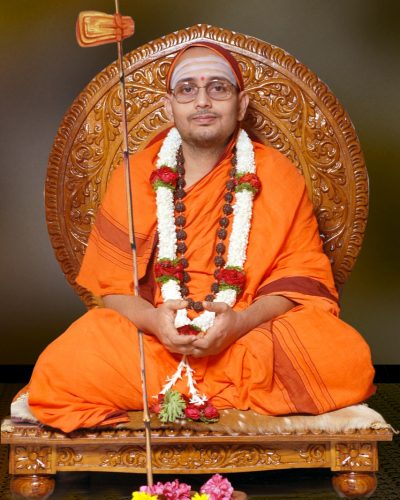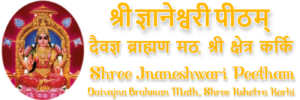Shree Jnaneshwari Peetha
History
Daivajna Brahman Math
About
Daivajna Brahmans - A Brief History

The role of Daivajna Brahmans in practisingAstrology is memorable. The word Daivajna and astrology are inextricablylinked. The history of Daivajna Brahmans may not have been recorded properly from time to time, even some records made, have been destroyed by foreign invaders, may have been lost because of earthquake and migration etc. Since no proper documentation of history is available, there are some loose comments about the history of Daivajna Brahmans which is not worthy of any attention.
Some Sociologists, British authors have grouped Daivajna Brahmans along with the Vishwakarma community because of the occupation similarity. Even there is a confusing statement mentioning that Daivajna Brahmans are originally from Bengal. Unfortunately, the unquestionable history of Daivajna Brahmans is difficult to be made available.
“Shet” is the abbreviation of the Sanskrit word “Shreshti”. Since Daivajna Brahmans were connected with gold, diamond occupation, they may have been called Shet. Like Priests are addressed as Bhat, Sharma similarly the name Shet is still in practice.
The resident of Ujjain during the second Chandragupta period (4th century), famous astronomer Varahamihira wrote his book on astrology which he named ‘Daivnja Vallabh’. Many other books were written during that period. The texts related to astrology were composed in Sanskrit.
Though some of these texts are not available, it can be said that there is a connection between astrology and Daivajna. With this background, it can be inferred that the ancestors of Daivajna Brahmans may have been great astrologers or astronomers.
Daivajna Brahmans follow the ‘Chandraman’ system. According to the Nehru research centre committee, on the banks of the Saraswati river sages, pundits, Brahmins etc. were always engaged in religious activities, chanting mantras and imparting education in the Gurukul system.
When the famine drought appeared, the Vedic Brahmincommunities migrated to the West, Sindh, to the North, Kashmir to the East, The Ganges and to South to the Saurashtra Konkan Coast. Historians record that ithappened 2500 years ago. Most Daivajna Brahmans, Saraswats migrated to theKonkan region and rural areas. The migrated Brahmins were looked after well bykings of the respective region. The Brahmins were allowed to practice theirreligious activities in their separate residential area.
The Brahmins who received such assistance, grants were called Mahajans. Records in this regard were available in temples (carved on stones) during that period, however, they were destroyed with the destruction of temples. Judicial inquiries by the kings have ascertained that Daivajna Brahmans were originally healers. This is reinforced by the text, Vishwa Brahma Kulotsava. Traditionally, Shiva-Shakti deities have been worshipped as Kuladevas since ancient times. In the long run, the propagation of Buddhist-Mahavirian atheism is strongly opposed to astrology and idol worship etc. Hence Daivajna Brahmans found it difficult to manage their livelihood with their routine Vedic activities and hence they had to accept gold smithy as an occupation. For this change in occupation, certain other communities who were jealous, also played an important role.
The Portuguese first entered India during the 16th century for trade from abroad and gradually occupied the country by military force, to establish dominion in the western province. Injustice, torture, death sentence etc. were imposed on Brahmins. The community was in a helpless situation. They destroyed temples banned Vedic activities. As they could not tolerate the violence of the Portuguese, they had to abandon their home-town-temple-kuladevaru-etc. of religious tradition. As a result, during the 17th century, Daivajna Brahmans Migrated to southern Karnataka, Kerala and Maharashtra.
There is a need for the present generation to know how hard their ancestors suffered. Proper documentation of the history of Daivajna Brahmans is necessary which will be inspirational for the youth of today. It is the ancestral heritage of the Vedic tradition of Daivajna Brahmans which will guide the youth to become good citizens.
Goa and Maharashtra’s Daivajna Brahmans and counterpartsstill recollect the fact that Daivajna Brahmans had a strong religiousaffiliation with Matha of Sri Gowdapadacharya Kaivalya (Kaval) who happens tobe the Guru of Sri Govind Bhagavatpadacharyas and Adi Shankaracharya, theAdvaita philosopher. As per the 7th-century records for Konkani speakingBrahmins Kaivalya Mutt was the original math. However, due to some unavoidablereasons, the relationship was lost.
Until the 1980s, the Daivajna Brahman community did nothave their own Guru and Math. They were worshipping their kuldevatas and livingwith dignity in society. Gradually the urge to have a Guru and Math for thecommunity started becoming a major activity in the community.
Finally facing all odds, they succeeded in establishing aMatha as per the Sri Shankar Advaita principles. In the year 1986, at Karki, inHonnavar taluk in U K district, Sanyasa Diksha was given to the newly identifieddisciple by Srimad Abhinavoddand Narasimha Bharati Swamiji of Vidyaranya Math ofHampi.
At Adi Shankaracharya Vedpathashala in Dharwad, the nominated Swamiji had Vedic education and in the year 1996, Sri Sri Bharati TirthaMahaswamiji, Sringeri Shankaracharya Jagadguru named our parampoojya Swamiji as “Sri SriSachidanandaJnaneswaraBharatiya Mahaswami”. Thus the Daivajna Brahmans got their first Guru, Math with the blessings of Sri Jnaneshwari Devi. With a small beginning, the Daivajna Matha at Karki has now been able to attract people from all over the country with its fruitful, religious, social and educational activities. It is heartening to note that the Daivajna Brahmins have now achieved a respectful position in society with their involvement and hard work in all fields.
